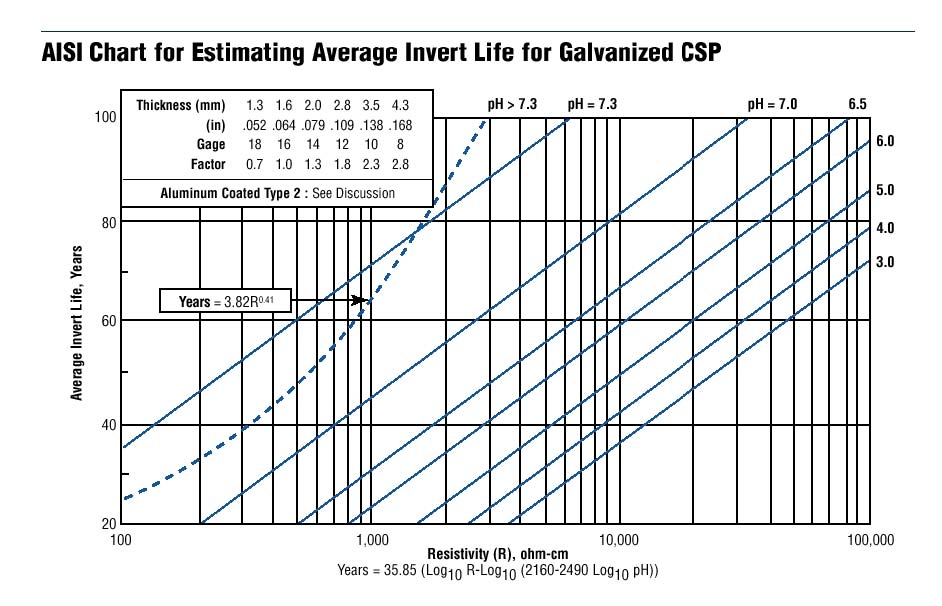Designing For Service Life
After a structure shape and size is selected based upon hydraulic or clearance requirements and the structure gage is determined, the designer should normally proceed to an analysis of the possible effects of the environment on structure performance. This may lead the designer to specific selections of material, structure type, coating, or invert protection.
Structure life can be affected by the corrosive action of the backfill in contact with the outside of a structure or more commonly by the corrosive and abrasive action of the flow in the invert of the structure. The design life analysis of the structure should include a check for both water side and soil side environments to determine which is most critical or which governs structure life.
The choice of material or structure type can be extremely important to service life. For example, if it is determined that water flowing through a structure is projected to limit the life of the invert through abrasive or corrosive action, an arch may be used with a natural invert or the invert may be paved. Other possible remedies may exist depending upon other structure requirements.
Galvanized Steel Structural Plate
With regard to the durability of galvanized steel structural plate, this design guide will outline the guidelines established by the California Department of Transportation (CALTRANS). The CALTRANS design method originated from a study that inspected over 7,000 galvanized steel corrugated metal pipe (CMP) drainage structures throughout the state of California. Through this field study they were able to develop a reliable method for predicting the service life of smaller diameter corrugated galvanized steel pipes. The data collected reflected the combined effects of corrosion and a wide range of abrasive levels.

The conclusion of the CALTRANS study defined the end of the structure life to be coincident with the first perforation (or approximately 12% metal loss) in the invert of culverts that have received no special maintenance.
The service life of 2 oz. per square foot of zinc-coated galvanized CMP is determined by using the CALTRANS chart for estimating invert life (see page 8). This chart predicts a variable service life based on pH and resistivity of water and soil and has been the industry standard for many years. The results included the combined effects of soil-side and interior corrosion, as well as the average effects of abrasion. For pipes where the pH was greater than 7.3, soil-side corrosion controlled and life was predicted by resistivity. For pipes were pH was less than 7.3, the interior invert corrosion generally controlled and both pH and resistivity were important.
It is important to note, the consequences of small perforations are minimal in gravity flow pipe systems, such as most storm sewers and larger culverts, and may not accurately reflect the estimated service life outlined by CALTRANS. Because of this fact, the original CALTRANS curves have been converted to average service life curves using data on weight loss and pitting in bare steel developed by National Institute of Standards and Technology. Using this information, the American Iron and Steel Institute (AISI) developed a durability chart using the end of an average effective service life to be estimated at approximately a 25% metal loss in the invert. The AISI chart can be found at NCSPA.org.
In addition, the structural plate covered in this design guide utilizes a 3 oz. per square foot of zinc coating and uses heavier gage material as part of the structural design. This is a 50% increase in additional barrier coating and adds additional base metal thickness that was not investigated in the original CALTRANS study. These two additional key factors will provide a longer service life than predicted in these charts.

If the designer has site specific knowledge and understands the key design parameters, the AISI method may be more applicable in the pipe service life design. Many state DOT’s find the CALTRANS method to be a conservative estimate of the average observed service life of galvanized steel structures in their states. Although a gravity flow drainage structure of any kind functions properly well beyond the occurrence of the first perforation, the use of the CALTRANS method best illustrates the variety of environmental conditions found throughout the country.
An important factor when choosing a design method, either CALTRANS or AISI, is knowledge of the structure backfill type. A structure backfilled with very fine material may be affected by the loss of this material through perforations. Thus, the CALTRANS method may be valid. If the backfill is more granular, which is usually the case with plate structures, then first perforation is probably inconsequential and, therefore, the AISI method would be more appropriate.
General Notes:
- User must also check structural requirements for gage selected.
- For further information see:
Copyright 2017, National Corrugated Steel Pipe Association